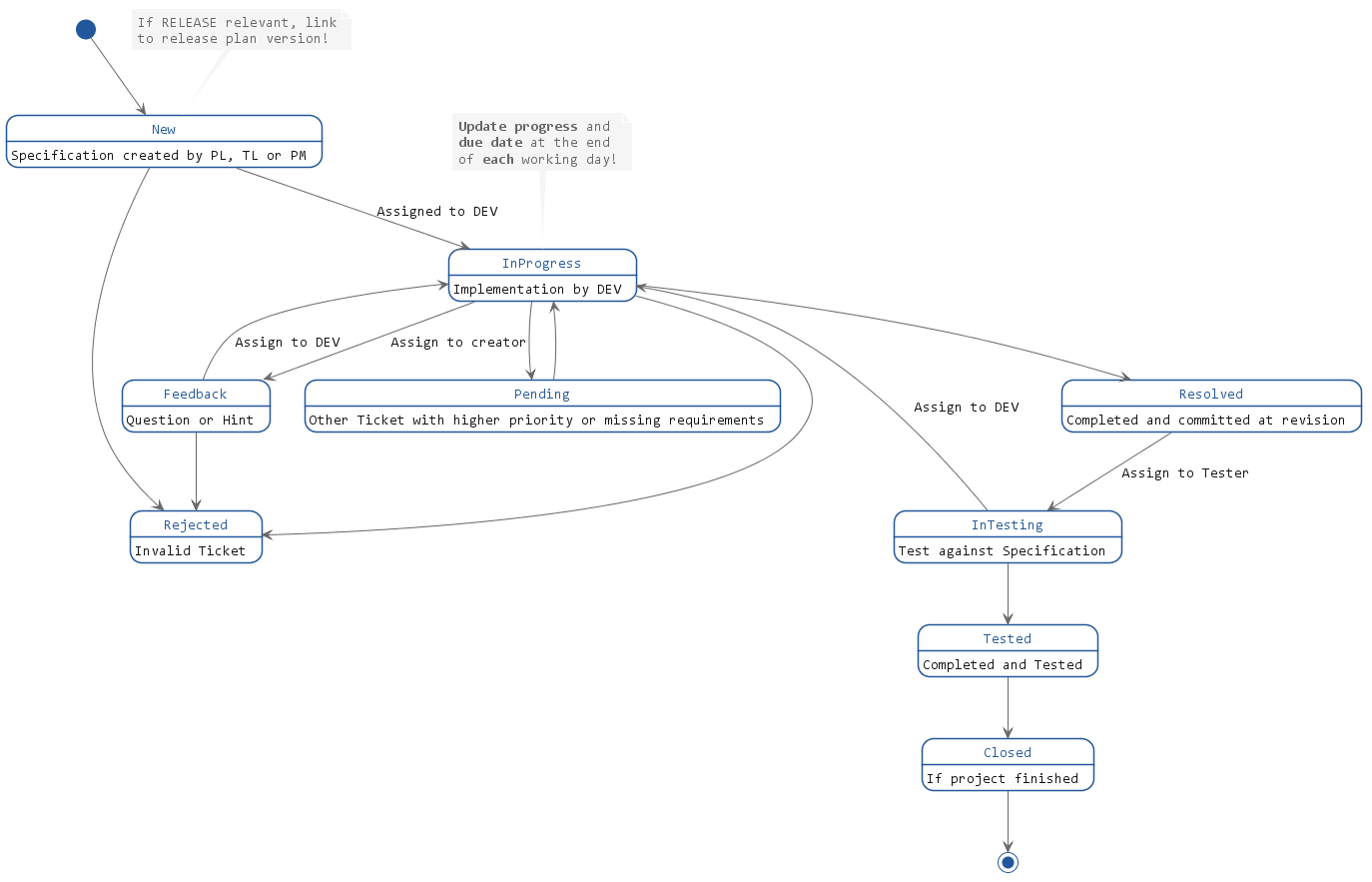 |
Software Quality Assurance
|
|
 |
Software Quality Assurance
|
|
The EMOTIVE Issue Tracking System is server-based software for the collaborative processing of tickets, see EMOTIVE Issue Tracking System. The system ensures that no task is lost and that a complete overview of the processes to be processed is possible at all times.
Note: EMOTIVE uses the open source software **Redmne* as an issue tracking system.
The administrator (role: PM) can create new users for the issue tracking system and assign them to projects. A user can be assigned one of the following roles for a project:
| Role | Description |
|---|---|
| Manager | Has all rights (PM, PL) |
| Developer | Developer rights (DEV) |
| Tester | Tester rights (Tester) |
| Reporter | May only create tickets (Tester) |
| Extern | For all users outside of EMOTIVE. |
Important: External users may only be assigned the role Extern!
Note: Depending on the role, the rights for the project are restricted.
The tickets are the central element. Tickets are assigned to projects. Tickets can be organized hierarchically and links can be created between tickets. Tickets include:
Depending on the content and purpose of the ticket, the ticket must be assigned one of the following types.
| Ticket Type | Description |
|---|---|
| Main | Main feature, usually has sub-tickets |
| Feature | New feature or enhancement |
| Gap/Lack | Defect or gap that does not prevent usage |
| Bug | Usage preventing error |
| General | General ticket outside of the implementation (e.g. effort estimation, specification creation etc.) |
| Support | Support request (no code changes) |
Note: The type of a ticket can change during processing. For example, if it is determined that it is not a bug but an incorrect application, the type can be changed from "Bug" to "Support".
All tickets are assigned to the employees. The employees process the tickets in the order of their priority and the date of creation. If a higher priority ticket is assigned during processing, the rules in the table below apply.
| Ticket Priority | Description |
|---|---|
| LOW | Subordinate, can be done at some point (background task) |
| NORMAL | Edit in order of creation |
| HIGH | A NORMAL ticket can be completed. A LOW ticket should be paused (Pending) but can be processed until the EOB. |
| URGENT | A HIGH ticket can be processed until the EOB. A NORMAL and LOW ticket must be paused (Pending) as quickly and reasonably as possible. |
| IMMEDIATE | All other tickets must be paused (Pending) as quickly and reasonably as possible. |
A ticket always has exactly one of the following states, whereby the status process is described in the flowchart.
| Ticket States | Description |
|---|---|
| New | The ticket is generated by the creator. It contains a simple, clear and sufficient specification of the task for the editor. If the ticket is RELEASE relevant a link to a certain Release Plan version must be added. |
| In Progress | The editor works on the ticket. The estimated progress and due date must be updated at the end of the working day! |
| Feedback | The editor has a question or a tip for the creator. |
| Pending | The editor has to pause the work due to another ticket or if some requirements missing. The reason for pending should be written in the ticket and the other ticket must be linked as a reference. |
| Resolved | The editor has completed and tested the work. A short summary as well as the revision number should be written in the ticket. |
| In Testing | The tester tests the implementation against the specification. |
| Tested | The tester successfully tested the implementation. He thus releases the implementation for delivery. |
| Closed | This optional status does not have to be used. It is only used to clean up the ticket system. |
| Rejected | The ticket is invalid. |
Important: In order to make the project progress transparent, especially for the customer, and thus to make it predictable, it is important that the due date and the progress are updated at the end of each working day. The values should be roughly estimated based on practical experience. The estimate is non-binding! No one will be judged for a wrong estimate! It is clear that the values can change completely during processing.

Tickets that are related to other tickets must be linked. The following relationships are possible:
| Relation | Description |
|---|---|
| Relationship | The ticket has a technical relationship with another ticket. |
| Duplicate | The ticket is a duplicate of another ticket. |
| Blocked | The processing of the ticket is blocked by another ticket, see also Status Pending. |
| Predecessor | Before the ticket can be processed, another ticket must first be completed. |